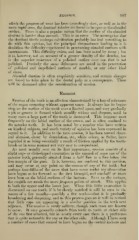Page 987 - My FlipBook
P. 987
EROSION. 997
Avhich the progress of wear has been exceedingly slow, as well as in the
more rapid ones, the dentinal tubnles are found to be open at the abraded
surface. There is also a popular notion that the surface of the abraded
dentine is harder than normal. This is an error. The assumption that
the dentinal fibrils undergo calcification probably has had something to
do with this opinion, but the principal circumstance leading to it is
doubtless the difficulty experienced in penetrating abraded surfaces with
instruments. This difficulty exists, and has been noted by many ; but
it is, however, not on account of a greater density of the dentine, but
is the superior resistance of a polished surface over one that is not
polished. Precisely the same differences are noted in the penetration
of polished and unpolished surfaces of marble, or any other kind
of stone.
Abraded dentine is often exquisitely sensitive, and certain changes
are found to take place in the dental pulp as a consequence. These
will be discussed after the consideration of erosion.
Erosion.
Erosion of the teeth is an affection characterized by a loss of substance
of the organ occurring without apparent cause. It always has its begin-
ning on the surface of the tooth over a limited space, and very gradually
a pit or groove is formed which steadily widens and deepens, until in
many cases a large part of the tooth is destroyed. This happens most
frequently on the labial surface of the crown, and is often confined to
the anterior teeth. It has been noted by a number who have written
on kindred subjects, and much variety of opinion has been expressed in
In addition to the term erosion, it has been termed chem-
regard to it.
ical abrasion, decay by denudation, etc., while others, as Salter, have
regarded it as being essentially a result of friction applied by the tooth-
brush or in some manner not very easy to comprehend.
As most usually seen on its first appearance, erosion consists of a
slight cup- or dish-shaped excavation in the enamel of some one of the
anterior teeth, generally situated from a half line to a line below the
free margin of the gum. It is, how'cver, not confined to this position,
and may occur at any point on the crowns of any of the teeth ; but
perhaps four-fifths of the cases that have come under my observation
have begun as far forward as the first bicuspid, and one-half or more
have been on the labial surfaces of the incisors. Next to the incisors,
the cuspids are much the more frequent points of attack. This applies
to both the upper and the lower jaw. When this little excavation is
discovered on one tooth, if it be closely watched it will be seen in the
— it
course of a few months possibly a few weeks—that is gradually
broadening and deepening, and as this process goes on it will be noticed
that little cups are appearing in a similar position in the teeth next
adjacent. The erosion is rarely solitary, though such cases are known
to occur. It very generally extends from tooth to tooth at either side
of the one first attacked, but in nearly every case there is a preference
that is quite noticeable for one or the other side. Although I have seen
a number of cases that seemed to have be^un on the central incisors and


